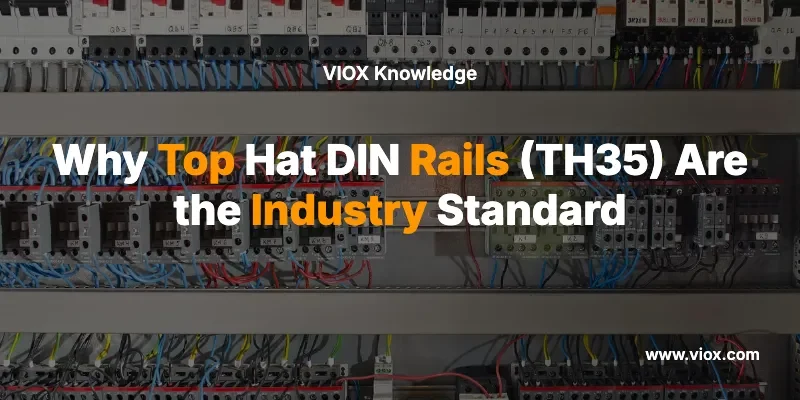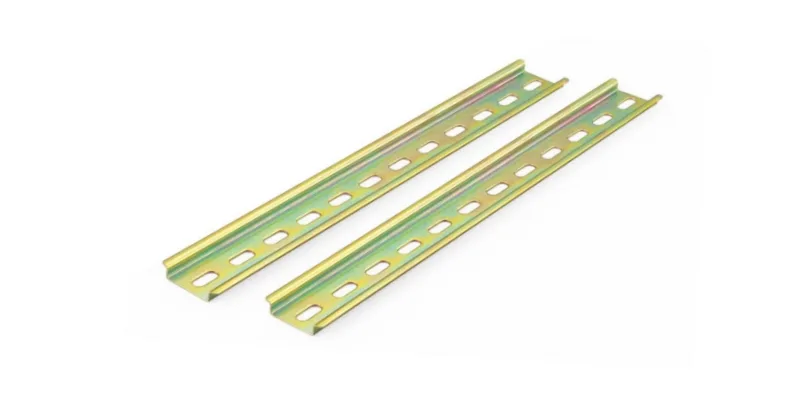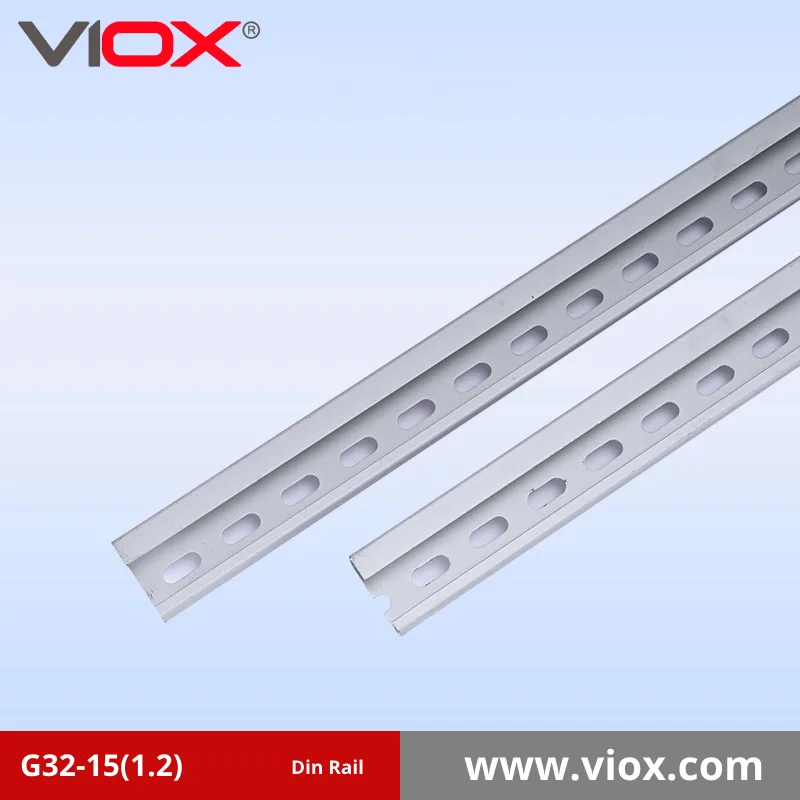Tóm lại: Phần chóp mũ (TH35) đã trở thành tiêu chuẩn công nghiệp cho thanh ray DIN nhờ thiết kế đối xứng, chiều rộng phổ biến 35mm, khả năng tương thích mô-đun với chiều rộng linh kiện 18mm và dễ lắp đặt hơn so với thanh ray hình chữ G và hình chữ C trước đây.
Phần mũ chóp cao thanh ray DIN, được đặt tên chính thức là TH35 hoặc TS35, đã nổi lên như một giải pháp lắp đặt chủ đạo trong các ứng dụng điện công nghiệp trên toàn thế giới. Các thanh ray kiểu mũ chóp được coi là tiêu chuẩn công nghiệp về mặt ray DIN, và là loại thanh ray dễ dàng tìm thấy nhất. Việc hiểu được lý do tại sao loại thanh ray này lại được áp dụng rộng rãi như vậy cho thấy sự phát triển của thiết kế tủ điện và những lợi ích thiết thực thúc đẩy quá trình tiêu chuẩn hóa công nghiệp.
Sự phát triển lịch sử: Từ G-Section đến Top Hat thống trị
Câu chuyện về tiêu chuẩn hóa thanh ray DIN bắt đầu vào năm 1928 tại Đức, khi khái niệm ban đầu được phát triển và triển khai tại Đức vào năm 1928, và được chi tiết hóa thành các tiêu chuẩn hiện tại vào những năm 1950. Khái niệm ban đầu về thanh ray có hình dạng chữ G, tạo ra kết nối cơ học chắc chắn, ngăn chặn việc lắp đặt ngược và cho phép điều chỉnh vị trí chính xác của các khối đầu cuối khi chúng có thể trượt dọc theo thanh ray theo chiều ngang.
Tuy nhiên, thiết kế thanh ray tiết diện G có những hạn chế. Thanh ray tiết diện G và các thành phần của nó nhanh chóng được các nhà sản xuất thiết bị điện khác áp dụng, và sau đó được bổ sung thêm thiết kế dạng "top-hat", một phiên bản thanh ray đối xứng, phù hợp hơn với việc lắp đặt các linh kiện nhẹ hơn. Sự phát triển này đánh dấu một bước ngoặt quan trọng trong các giải pháp lắp đặt công nghiệp.
Những ưu điểm chính khiến Top Hat trở thành tiêu chuẩn
1. Thiết kế đối xứng cho việc lắp đặt phổ biến
Ưu điểm quan trọng nhất của phần mũ chóp nằm ở chỗ hồ sơ đối xứngThiết kế Top Hat là thanh ray lắp đặt đối xứng, tiêu chuẩn công nghiệp, giúp loại bỏ sự nhầm lẫn khi lắp đặt. Không giống như thanh ray tiết diện chữ G bất đối xứng, các linh kiện có thể được lắp đặt theo cả hai hướng, giúp giảm thiểu lỗi lắp đặt và đơn giản hóa việc đào tạo kỹ thuật viên.
2. Tiêu chuẩn chiều rộng tối ưu 35mm
Chiều rộng 35mm của ray mũ chóp thể hiện sự cân bằng hoàn hảo giữa tính linh hoạt và hiệu quả không gian. Ray rộng 35mm này được sử dụng rộng rãi để lắp đặt máy cắt, rơle, bộ điều khiển logic lập trình, bộ điều khiển động cơ và các thiết bị điện khác. Chiều rộng tiêu chuẩn này đã được áp dụng rộng rãi vì nó phù hợp với phần lớn các linh kiện điện công nghiệp trong khi vẫn duy trì bố cục tủ điện nhỏ gọn.
3. Hệ thống thành phần mô-đun
Có lẽ khía cạnh khéo léo nhất của tiêu chuẩn mũ chóp là cách tiếp cận mô-đun của nó. Chiều rộng của các thiết bị được lắp trên thanh DIN "mũ chóp" 35 mm thường sử dụng "mô-đun" làm đơn vị chiều rộng, mỗi mô-đun rộng 18 mm. Ví dụ, một thiết bị nhỏ (ví dụ như máy cắt) có thể có chiều rộng là 1 mô-đun (rộng 18 mm), trong khi một thiết bị lớn hơn có thể có chiều rộng là 4 mô-đun (4 × 18 mm = 72 mm).
Hệ thống mô-đun này tạo ra một hệ sinh thái chuẩn hóa trong đó:
- Quy hoạch không gian trở nên có thể dự đoán được – các kỹ sư có thể tính toán chính xác các yêu cầu về tấm pin
- Khả năng hoán đổi linh kiện được đảm bảo trên khắp các nhà sản xuất
- Sử dụng không gian hiệu quả được tối đa hóa trong bảng điều khiển
4. Khả năng tương thích giữa các nhà sản xuất
Điểm mạnh nhất của tiêu chuẩn Top Hat nằm ở việc nó được áp dụng rộng rãi. Việc hệ thống thanh ray DIN ngày nay được công nhận là một loạt các tiêu chuẩn cố định và nhất quán đồng nghĩa với việc người lắp đặt có thể đảm bảo tính đồng nhất về kích thước trên toàn bộ bộ sản phẩm liên quan, bất kể công ty nào sản xuất hoặc cung cấp từng bộ phận riêng lẻ.
Khả năng tương tác này mang lại một số lợi ích quan trọng:
- Thiết kế linh hoạt không có sự ràng buộc của nhà cung cấp
- Tối ưu hóa chi phí thông qua nguồn cung ứng cạnh tranh
- Mở rộng trong tương lai khả năng với bất kỳ thành phần nào của nhà sản xuất
- Giảm độ phức tạp của hàng tồn kho cho các đội bảo trì
Thông số kỹ thuật xác định tiêu chuẩn
Kích thước và biến thể tiêu chuẩn
Thanh ray mũ chóp cao được sản xuất theo hai cấu hình độ sâu chính:
- Độ sâu tiêu chuẩn: 7,5mm – 7,5mm (Tiêu chuẩn): Được chỉ định theo IEC/EN 60715 – 35 × 7,5. Phù hợp với phần lớn các ứng dụng thông dụng.
- Mũ sâu: 15mm – 15mm (Deep Hat): Được chỉ định theo IEC/EN 60715 – 35 × 15. Cấu hình sâu hơn này cung cấp độ bền và độ cứng lớn hơn để lắp các thành phần nặng hơn hoặc kéo dài khoảng cách rộng hơn giữa các điểm lắp.
Tiêu chuẩn vật liệu và xây dựng
Vật liệu phổ biến nhất được sử dụng để sản xuất thanh ray DIN là thép tấm cacbon cán nguội. Quy trình chế tạo tiêu chuẩn bao gồm mạ kẽm để chống ăn mòn, đảm bảo độ tin cậy lâu dài trong môi trường công nghiệp.
Lợi ích lắp đặt và vận hành
Lắp ráp linh kiện nhanh chóng
Thiết kế mũ chóp cho phép quy trình lắp đặt hiệu quả vượt trội. Chúng tiết kiệm thời gian và công sức – các thành phần chỉ cần bấm hoặc trượt vào vị trí trên thanh ray, thay vì phải lắp từng thành phần riêng lẻ. Khả năng bấm này giúp giảm đáng kể thời gian lắp ráp so với các phương pháp lắp đặt truyền thống đòi hỏi phải cố định từng thành phần riêng lẻ.
Tối ưu hóa không gian
Tiết kiệm không gian – Các đầu nối DIN rail và các linh kiện lắp đặt DIN nhỏ hơn có thể được đóng gói gọn gàng trong không gian nhỏ hơn. Thiết kế nhỏ gọn của thanh ray chóp đỉnh giúp tối đa hóa không gian sử dụng của bảng điều khiển, đồng thời vẫn đảm bảo tính toàn vẹn về mặt cấu trúc cho các linh kiện lắp đặt.
Bảo trì Khả năng tiếp cận
Hệ thống lắp đặt tiêu chuẩn hóa giúp đơn giản hóa các hoạt động bảo trì đang diễn ra. Các thành phần có thể dễ dàng tháo rời, thay thế hoặc di dời mà không cần sửa đổi bảng điều khiển, giúp giảm thời gian ngừng hoạt động và chi phí bảo trì.
Ứng dụng công nghiệp thúc đẩy việc áp dụng tiêu chuẩn
Hệ thống tự động hóa công nghiệp
Thanh ray DIN TS35 rất phổ biến để lắp đặt nhiều loại sản phẩm và linh kiện điều khiển công nghiệp điện, từ máy cắt và bộ điều khiển động cơ đến I/O từ xa, máy biến áp, bộ truyền động và nhiều hơn nữa. Tính chất mô-đun hoàn toàn phù hợp với các yêu cầu tự động hóa hiện đại, nơi các linh kiện thường xuyên cần cập nhật hoặc mở rộng.
Hệ thống quản lý tòa nhà
Tự động hóa tòa nhà thương mại và dân dụng ngày càng phụ thuộc vào việc lắp đặt thanh ray DIN cho các hệ thống điều khiển HVAC, hệ thống chiếu sáng và thiết bị quản lý năng lượng. Độ tin cậy và khả năng mở rộng của tiêu chuẩn Top Hat khiến nó trở nên lý tưởng cho các ứng dụng đang phát triển này.
Phân phối và kiểm soát điện năng
Tủ phân phối điện trên toàn thế giới đã được chuẩn hóa trên thanh ray mũ cao để lắp đặt các thiết bị bảo vệ, đồng hồ đo và thiết bị điều khiển. Khả năng tương thích phổ quát đảm bảo quy trình lắp đặt nhất quán ở nhiều quốc gia và ứng dụng khác nhau.
So sánh với các thanh ray DIN thay thế
Thanh ray C-Section: Ứng dụng cũ
Thanh ray DIN TS32 rộng 32mm từ mép này sang mép kia, có mặt cắt hình chữ C với đường cong đối xứng ở các cạnh ngoài. Ngày nay, đây thường được coi là một tiêu chuẩn cũ của hệ thống lắp đặt thanh ray DIN, vốn phổ biến hơn trong những năm đầu áp dụng rộng rãi nhưng hiện đã bị biến thể TS35 vượt mặt.
Thanh ray hình chữ C cần có bộ chuyển đổi cho các thành phần hiện đại, làm tăng thêm độ phức tạp và chi phí lắp đặt.
Thanh ray G-Section: Sử dụng chuyên dụng cho mục đích chịu tải nặng
Thanh ray G thường được sử dụng để giữ các linh kiện nặng hơn, công suất cao hơn. Nó được lắp đặt với mặt sâu hơn ở phía dưới, và thiết bị được móc qua mép, sau đó xoay cho đến khi nó khớp vào mặt nông hơn. Mặc dù vẫn được sử dụng cho các ứng dụng nặng cụ thể, thanh ray G thiếu tính linh hoạt và dễ lắp đặt, khiến thanh ray mũ chóp trở thành lựa chọn ưu tiên cho hầu hết các ứng dụng.
Tiêu chuẩn và tuân thủ toàn cầu
Tiêu chuẩn công nghiệp của phần mũ chóp cao được củng cố bằng các tiêu chuẩn quốc tế toàn diện:
- Tiêu chuẩn Châu Âu EN 50022: Thông số kỹ thuật cho thiết bị đóng cắt và điều khiển điện áp thấp dùng trong công nghiệp. Thanh ray lắp đặt. Thanh ray chóp cao rộng 35 mm để lắp đặt thiết bị bằng chốt bấm.
- Tiêu chuẩn quốc tế IEC 60715: Kích thước của thiết bị đóng cắt và điều khiển điện áp thấp. Lắp đặt chuẩn trên thanh ray để hỗ trợ cơ học cho các thiết bị điện trong hệ thống thiết bị đóng cắt và điều khiển.
- Nhiều tiêu chuẩn quốc gia bao gồm DIN 46277-3, BS 5584 và AS 2756.1997
Các tiêu chuẩn này đảm bảo khả năng tương tác toàn cầu và thông số kỹ thuật sản xuất nhất quán trên toàn thế giới.
Chuẩn bị cho tương lai thông qua tiêu chuẩn hóa
Tích hợp Công nghiệp 4.0
Mặc dù thanh ray mũ chóp cao đã được sử dụng từ lâu trong công nghiệp 4.0, nhưng chúng vẫn rất quan trọng. Các mô-đun chịu trách nhiệm giao tiếp giữa người và máy (như ổ cắm mạng) đều có sẵn theo các tiêu chuẩn cần thiết để lắp đặt trên thanh ray mũ chóp cao.
Khả năng tương thích của các công nghệ mới nổi
Các thành phần tự động hóa hiện đại, thiết bị IoT và công nghệ tòa nhà thông minh tiếp tục áp dụng tiêu chuẩn lắp đặt hàng đầu, đảm bảo rằng cơ sở hạ tầng hiện có vẫn tương thích với công nghệ tiên tiến.
Tác động kinh tế của tiêu chuẩn hóa
Việc áp dụng thanh ray mũ chóp cao làm tiêu chuẩn của ngành đã mang lại những lợi ích kinh tế đáng kể:
- Giảm chi phí lắp đặt thông qua các thủ tục lắp đặt đơn giản hóa
- Yêu cầu hàng tồn kho thấp hơn do khả năng tương thích phổ quát
- Giảm nhu cầu đào tạo với các phương pháp cài đặt tiêu chuẩn
- Tăng cường hệ thống tin cậy thông qua các giải pháp lắp đặt đã được chứng minh
- Hoạt động bảo trì được đơn giản hóa với các thành phần có thể hoán đổi cho nhau
Kết luận: Sự lựa chọn rõ ràng cho các ứng dụng hiện đại
Phần mũ chóp (TH35) đạt tiêu chuẩn công nghiệp nhờ sự kết hợp giữa các ưu điểm thiết kế thực tế, khả năng tương thích phổ quát và lợi ích kinh tế, giải quyết các thách thức lắp đặt và bảo trì thực tế. Cấu hình đối xứng, hệ thống linh kiện mô-đun và tuân thủ các tiêu chuẩn toàn diện khiến nó trở thành lựa chọn hợp lý cho các chuyên gia điện trên toàn thế giới.
Mặc dù bị một số người đánh giá thấp, thanh ray DIN vẫn mang lại hiệu suất quan trọng cho mọi loại hình lắp đặt điện. Chúng tiết kiệm thời gian, không gian và tiền bạc, đồng thời đảm bảo dự án luôn thống nhất theo tiêu chuẩn quốc tế và dễ dàng mở rộng quy mô trong tương lai.
Đối với các kỹ sư, thợ điện và nhà thiết kế hệ thống, việc hiểu được lý do tại sao phần mũ chóp trở thành tiêu chuẩn sẽ giúp họ hiểu rõ hơn về việc lựa chọn giải pháp lắp đặt hiệu quả nhất cho các hệ thống điện hiện đại. Việc áp dụng rộng rãi cấu hình này không chỉ phản ánh tiền lệ lịch sử mà còn là những lợi thế thực tế liên tục, có khả năng sẽ duy trì vị thế thống trị của nó trong các ứng dụng công nghiệp trong nhiều thập kỷ tới.
Liên quan
Cách xác định chất lượng của thanh ray DIN
DIN Rail so với Lắp đặt truyền thống
5 lý do hàng đầu tại sao thanh ray DIN lại cần thiết trong các hệ thống điện hiện đại






